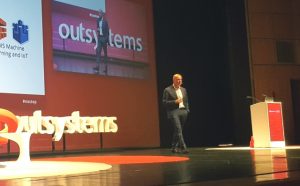Jaded technology veterans may look at the exploding Low-Code marketplace and see little more than warmed-over trends from the 1980s and 1990s.
After all, Computer Aided Software Engineering (CASE), Fourth-Generation Languages (4GLs) and Rapid Application Development (RAD) all promised faster, streamlined software development. What’s different today?
At this week’s OutSystems NextStep conference, numerous customers stepped up to the mic and answered that question with real-life stories about solutions that would have been inconceivable in the CASE/4GL/RAD days.

OutSystems CEO Paulo Rosado kicked off the conference by drawing the line in the sand. “What happened with PowerBuilder [from Appeon and SAP], [Microsoft] SharePoint, and [Microsoft] Access?” Rosado asked. “They were impossible to scale. You ran into the wall of reliability, maintainability, scalability. It’s that wall that’s the plague of the low-code category.”
Add to that list of plagues: modernization and integration challenges. In today’s enterprise environment, apps rarely if ever run in isolation. They must both connect to – and in many cases, help to replace – existing applications.
Older RAD tools and their ilk simply weren’t up to these challenges. “When we’re talking about rewriting legacy systems, we’re talking about agility at scale,” Rosado continued.
Read the entire article at https://www.forbes.com/sites/jasonbloomberg/2017/09/21/curing-the-plague-of-low-code/.
Intellyx publishes the Agile Digital Transformation Roadmap poster, advises companies on their digital transformation initiatives, and helps vendors communicate their agility stories. As of the time of writing, Microsoft and OutSystems are Intellyx customers. None of the other organizations mentioned in this article are Intellyx customers. OutSystems covered Jason Bloomberg’s expenses to NextStep, a standard industry practice. Image credit: Jason Bloomberg.



